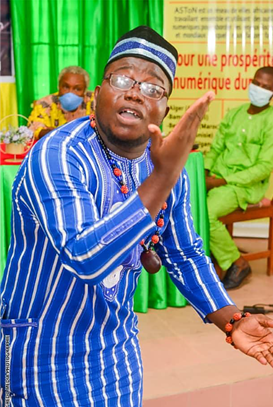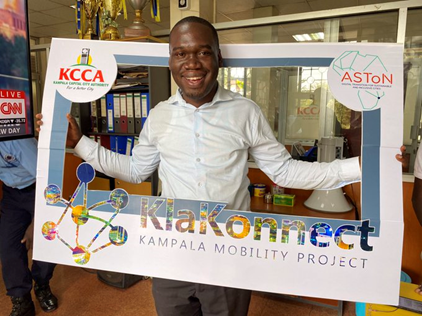The digital transition of municipal services: how to ensure citizen engagement?
The “ASToN City Week”, the week during which representatives of the ASToN network’s 11 cities met in Kigali (Rwanda) was organized around one main theme: how to make ASToN a success? This aim was translated into different sessions like: coaching carousel and peer-to-peer exchanges, presentations and workshops on the issue of sustainability, visits to the city and to these innovative projects. The exchange of experiences, a concept at the heart of the network, was central to all these sessions. But how to allow a very diverse and international group to speak freely during professional meetings while avoiding too much formality? This is the question we asked ourselves as we started designing the event.
The “Open Session” format responds to this problem. This type of sessions takes the form of a meeting where participants suggest and vote on the agenda. Anyone who wants to suggest or lead a discussion topic can do so, and then the group votes on what they want to discuss the most. The goal is to give everyone a chance to contribute.

On Friday, the last day of the meeting, participants organized themselves into 5 groups to discuss different topics related to their respective local ASToN projects, including communication.
External communication issues are particularly critical to ensure citizen buy-in to municipal initiatives, as citizens are the main beneficiaries of these projects. “The projects of the cities in the ASToN network focus largely on soft skills, capacity building, and the human skills of both service users and staff. In order for the population to better grasp the positive transformations underway, ASToN cities seek to implement clear and adapted communication activities” explains to us Joyce Mavoungou, Cities Project Officer with ASToN. More than simply transmitting information, the objective is to create a sense of ownership.
In addition to the importance of involving them in the co-creation of the project, it seems central to know : How to communicate effectively with citizens?
Among the cities in the ASToN network, representatives from 4 cities (Sèmè-Podji — Benin, Kampala — Uganda, Nouakchott — Mauritania, Bamako — Mali) have been working on an answer to this question in the framework of ASToN.
1. Choosing the right way and time to communicate
Communication strategies should be thought out at the earliest stages of the project. They should clearly identify the target audiences, how and when to communicate. It is important to follow the progress of the project. Thus, at each milestone of the project, communicating with the citizens of the point reached is very important and allows creating a relationship of trust. In the framework of ASToN, since the citizens were involved during the identification of the problem, the preliminary research, or various survey activities, reporting to them on the finalization and validation of the local action plan, via social networks or other media, is a way to keep them updated, involved and interested. Among the discussion group, it was noted that citizens like to be updated on concrete results.
For Kampala, the most appropriate way to communicate in the local context, as identified by the local ASToN group, was through radio campaigns as soon as the action plan was developed. For Sèmè-Podji, it was public sketches.

2. Expressing oneself simply and clearly so that citizens can understand — even in several languages.
In many African cities, several languages are spoken quite widely. In order to reach a wide audience, it is necessary to adapt and prepare content that is translated into the majority languages. Illiteracy rates must also be taken into account. Thus, messages must be simple and easily understood: striking images, short sentences, key words, highlighting priorities and objectives.
For example, in Kampala, the radio campaign was in English and Luganda (one of the local languages); in Sèmè-Podji, the sketches were in French and two local languages, Hwla and Goun; and in Nouakchott, a motion design video in French was used, with other content in Arabic also being considered. In Bamako, the focus was on the massive and repeated use of the ASToN logo in order to mark the spirits.

3. Awareness campaigns and education are important
For ASToN cities, the project is not only a desire to optimize public services, but it is also part of a vision of digital transformation with the aim of improving people’s daily lives. It is therefore necessary to work on raising their awareness of various sustainability issues and to strengthen their ability to use digital tools.
“Certain habits must change.”
In the case of Sèmè-Podji, the sketches performed dramatized a local reality that the ASToN project aims to address: conflicts related to unsecured land transactions. With the ASToN project aiming at the digitization of land deeds, ownership titles and transactions, these conflicts should considerably decrease. But for this to happen, the populations will have to prepare themselves and get used to the new digital procedures.
Similarly, Bamako’s communication plan states that one of its objectives is to make beneficiaries aware of the expected results of the project, but also of the important potential offered to them, in the context of the digitization of the payment and access to the tax sticker of two-wheeled vehicles in the city.
4. A catchy language that people can understand and relate to
People need to be able to understand the project in broad terms, remember it, refer to it, and understand why it is beneficial to them and in line with their values, cultures, and lifestyles. Logos, catchy headlines, and image-based games are all ways to get that attention.
The city of Kampala was able to inspire the other three cities by explaining the choice of name for their mobility framework project: Kampala’s ASToN project, dealing with the development of an incident and traffic reporting application, is part of a larger city-wide strategic project called KlaKonnect. This initiative encompasses all mobility-related projects in the city and its name is drawn from a consultation with the citizens of Kampala.

The other cities participating in this exchange found the whole naming process very skilful, in the involvement of the population and the cultural aspect in the final choice. The ASToN network allows cities to learn from good practices and to adapt them to their local context.
We often hear “communication is key”. This also applies to city-related projects, especially with populations that should benefit from them. “For the ASToN network, citizens are central. Thus, in addition to involving them in an innovative way throughout the development of the project (surveys, consultation and co-creation workshops), we want to highlight the importance of transmitting not only the progress of the project but also the vision and ambitions in order to generate local ownership and thus the success of the project” adds Joyce. Indeed, without citizen ownership, projects cannot achieve their initial goal of improving services for users and staff.
Written by Joyce Mavoungou


